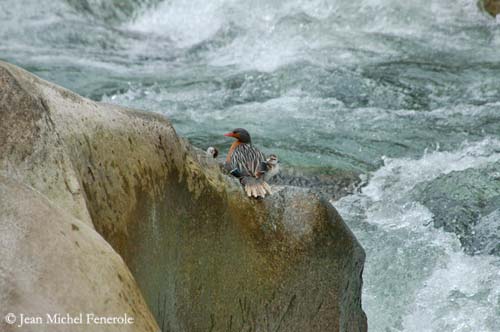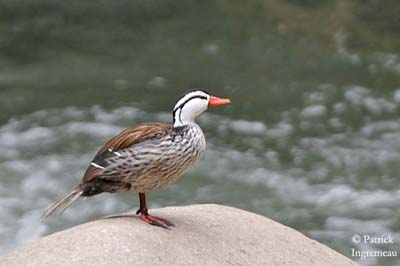
Fr: Merganette des torrents
All : Sturzbachente
Esp : Pato Torrentero
Ital: Anatra di torrente
Nd: Riviereend
Port: Pato crestón
Text by Nicole Bouglouan
Photographers :
Jean Michel Fenerole
Photos d’Oiseaux
Patrick Ingremeau
TAMANDUA
Sources :
HANDBOOK OF THE BIRDS OF THE WORLD vol 1 by Josep del Hoyo-Andrew Elliot-Jordi Sargatal - Lynx Edicions - ISBN: 8487334105
GUIDE DES CANARDS, DES OIES ET DES CYGNES – de Steve Madge - Delachaux et Niestlé - ISBN: 2603013769
Animal Diversity Web (University of Michigan Museum of Zoology)
BirdLife International (BirdLife International)
Torrent Duck
Merganetta armata
Anseriforme Order – Anatidae Family
BIOMETRICS:
Length: 43-46 cm
Weight: 315-440 g
DESCRIPTION:
All the pictures display the race « colombiana ».
Torrent Duck is an elegant South American duck which inhabits close to fast flowing mountain torrents where it nests and feeds. Actually, it could be have something similar to dippers!

Adult male of nominate race has black upper back, scapulars and tertials, broadly edged buff, grey or white, giving a bold striped effect.
Lower back and uppertail coverts are dark grey, very finely vermiculated white.
The long, stiff tail is rufous-brown. Wings are grey and rufous brown, with iridescent bright green speculum bordered with white on both sides.
Underparts are white to rufous-chestnut, streaked black. Throat and breast are black.
Head and hindneck are white with conspicuous black lines from forehead, bill base and eyes to the neck sides and the nape.
In nominate race, we can see the black chin and bill base, and a broad black stripe from the eye to the chin, crossing the cheek as a large black tear.
Bill is red-orange. Eyes are dark brown. Legs and feet are dull red with blackish webs.
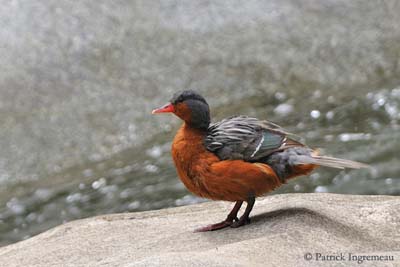
Female has grey top of head and hindneck finely vermiculated white. Upperparts are similar to male.
The whole underparts are bright chestnut-rufous from chin to undertail coverts. On the wings, the speculum is duller, darker than in male.
The juvenile is paler and duller than adult male, with barred flanks.
We find six subspecies.
The race “colombiana” displayed here shows differences in male’s plumage. It has greyish-white underparts streaked blackish. On the head, it lacks the black tear.
In the other races, we find “leucogenis”: male has blackish to dark brown breast and flanks streaked black and dark grey belly.
Race “turneri”: male has black underparts.
Race “garleppi”: male has brown streaked black underparts and darker upperparts.
Race “berlepschi” is very similar to “leucogenis”.
Race “armata” described above.
All races show slim body and long tail. Juveniles and females are similar to nominate.
VOICE: SOUNDS BY XENO-CANTO
Torrent Duck male gives sharp whistles which can be heard over the river noise. We can also hear deeper guttural calls from female, as squabble or quacking.
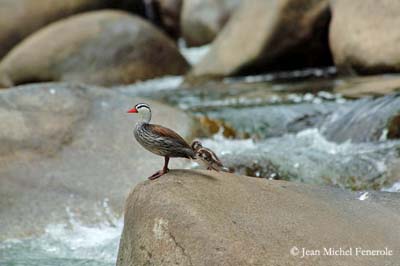
HABITAT:
Torrent Duck lives in fast-flowing mountain rivers, streams and torrents. The year-round territory includes rapids, boulders, waterfalls and gorges, but also wide areas of quiet waters.
This duck is visible from sea-level in Chile, up to 4500 metres of elevation in the Andes.
RANGE:
Torrent Duck is resident and breeds in the Andes in South America. The species occurs in the West coast of South America, from Venezuela to Tierra del Fuego.
BEHAVIOUR:
Torrent Duck feeds on aquatic preys, invertebrates such as insect larvae and molluscs, and probably some fish.
This duck forages in rivers by head-dipping while swimming, by upending and probing among rocks under water. It also forages behind the waterfalls, completely undisturbed by the falling water.
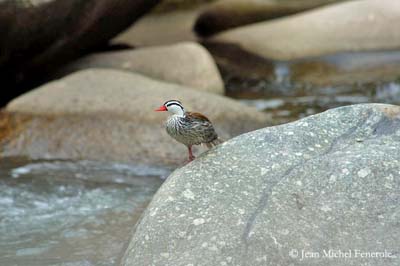
The Torrent Duck also dives, both for feeding and when disturbed. It usually swims with partially submerged body and dropped tail. But when threatened, it swims over long distances, with only head and neck above the surface.
It rests on the rocks above the water, often in the middle of the river. It is also able to swim under the surface and against the current if alarmed for over one minute. It flies close to the water over short distance if disturbed.
The Torrent duck is often seen in pairs or in family groups on the riversides perched on rocks. They are territorial and the male uses the spurs of the legs to avoid intruders.
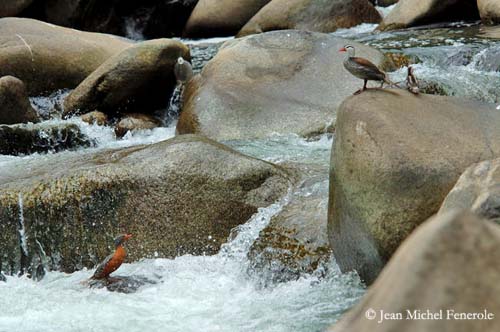
Several males can gather in groups to display. These ducks show long-term bonds. Male uses several displays such as bowing repeatedly, rapid flapping and kicking up water with the legs. Male and female also use vocal communication and they often swim around each other.
Adults seem to be sedentary, but they can move according to the weather conditions. The young birds wander within the range before to establish their own territory.
FLIGHT:
Torrent Duck is an expert diver, and it is probably better swimmer than flier. However, it is able to fly if necessary, but often over short distances such as to cross the river from one shore to another.
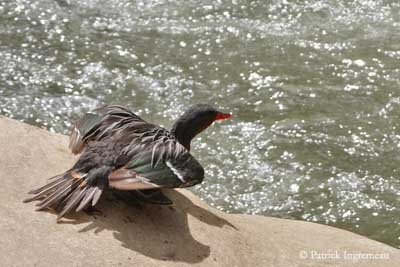
REPRODUCTION:
Breeding season varies according to the range.
Torrent Duck nests solitary in single pair. The nest is often made in natural cavity among rocks, hollows, or in dense vegetation. The cup is made with dry grass and the interior is lined with abundant down and some feathers. It is often situated in inaccessible places.
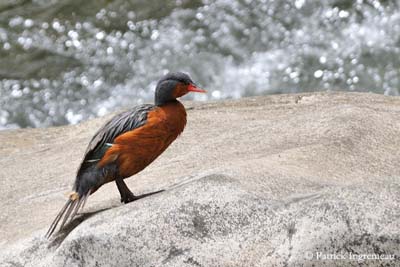
Female lays 3-4 dull buff eggs. Incubation by female lasts about 43-44 days, and is probably the longest period in this family. Chicks have strongly striped and spotted black and white down.
As usual in permanent-bonds species, the male has an active role in the nesting duties, sharing all the breeding tasks with the female except the incubation.
Both parents help the chicks to move into the dangerous waters and keep them between them. The chick is able to swim immediately in fast currents and parents often have to save them!
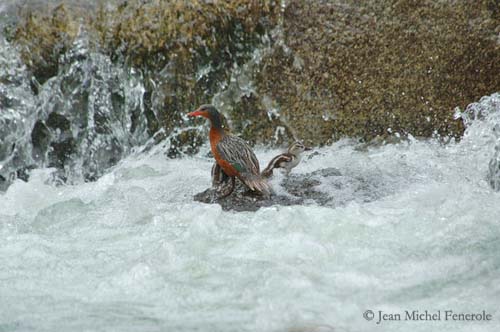
DIET:
Torrent Duck feeds on aquatic preys such as invertebrates and mainly insect larvae, molluscs and crustaceans, and probably some fish and terrestrial worms.
PROTECTION / THREATS / STATUS:
Torrent Duck is decreasing in most parts of the range, but mainly in the northern half. It is still locally common, but has disappeared from numerous rivers, due to erosion, damages by deforestation, fishing and hunting, and pollution. Competition for food with introduced trout plays also an important role in these declines.
